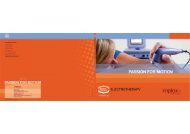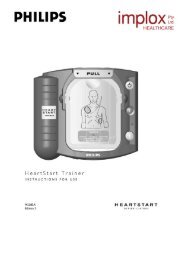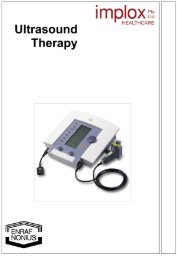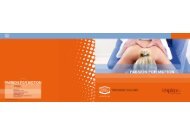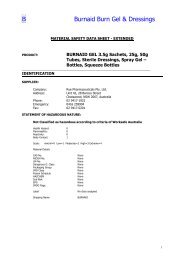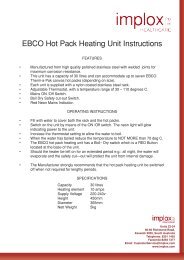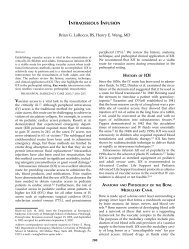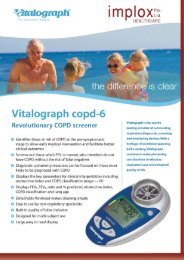Directions for Use - Implox
Directions for Use - Implox
Directions for Use - Implox
You also want an ePaper? Increase the reach of your titles
YUMPU automatically turns print PDFs into web optimized ePapers that Google loves.
H-2<br />
Electromagnetic immunity<br />
immunity test<br />
IEC 60601<br />
test level<br />
compliance<br />
level<br />
electromagnetic environment -<br />
guidance<br />
electrostatic discharge<br />
(ESD)<br />
IEC 61000-4-2<br />
± 6 kV contact<br />
± 8 kV air<br />
± 6 kV contact<br />
± 8 kV air<br />
There are no special requirements<br />
with respect to electrostatic<br />
discharge. a<br />
power frequency<br />
(50/60 Hz) magnetic field<br />
IEC 61000-4-8<br />
3 A/m 3 A/m Power frequency magnetic fields<br />
should be at levels characteristic of a<br />
typical location in a typical<br />
commercial/hospital environment.<br />
There are no special requirements <strong>for</strong><br />
non-commercial/non-hospital<br />
environments.<br />
radiated RF<br />
IEC 61000-4-3<br />
10 V/m<br />
80 MHz to 2.5<br />
GHz<br />
20 V/m Portable and mobile RF<br />
communications equipment should be<br />
used no closer to any part of the<br />
HeartStart, including cables, than is<br />
absolutely necessary. b,c The<br />
recommended separation distances<br />
<strong>for</strong> various transmitters and the AED<br />
are shown in the following table.<br />
Interference may occur in the<br />
vicinity of equipment marked<br />
with the following symbol:<br />
Laerdal Medical<br />
NOTE 1. At 80 MHz and 800 MHz, the higher frequency range applies.<br />
NOTE 2. These guidelines may not apply in all situations. Electromagnetic propagation is affected by absorption and<br />
reflection from structures, objects and people.<br />
a. Generally, AEDs are sometimes susceptible to interference generated by patient and/or responder motion in environments in which a high<br />
static electric field is present (e.g., low humidity, synthetic carpets, etc.). As a safety measure, HeartStart AEDs incorporate a patented<br />
method to sense possible corruption of the ECG signal by such interference and to respond by directing the user to stop all motion. In<br />
these cases, it is important to minimize movement in the vicinity of the patient during rhythm analysis in order to ensure that the signal<br />
being analyzed accurately reflects the patient’s underlying heart rhythm.<br />
b. The ISM (industrial, scientific and medial) bands between 150 kHz and 80 MHz are 6,765 MHz to 6,795 MHz; 13,553 MHz to 13,567 MHz;<br />
26,957 MHz to 27,283 MHz; and 40,66 MHz to 40,70 MHz.<br />
c. Field strengths from fixed transmitters, such as base stations <strong>for</strong> radio (cellular/cordless) telephones and land mobile radios, amateur radio,<br />
AM and FM radio broadcast, and TV broadcast cannot be predicted theoretically with accuracy. To assess the electromagnetic environment<br />
due to fixed RF transmitters, an electromagnetic site survey should be considered. If the measured field strength in the location in which the<br />
HeartStart is used exceeds the applicable RF compliance level above, the HeartStart should be observed to verify normal operation. If<br />
abnormal per<strong>for</strong>mance is observed, additional measures may be necessary, such as re-orienting or relocating the HeartStart.<br />
HEARTSTART M5067A



